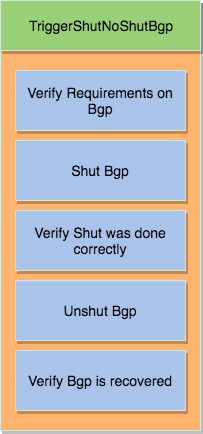Triggers
A trigger is a set of actions and verifications that, together, constitute a
testcase. These actions can include removal/addition of configuration, flapping
protocols/interfaces, perform HA events, and any other actions that a user may want to
perform to test his/her device. Triggers can also include verifications that
check whether or not the actions were performed correctly on the devices. We call these
verifications, local verifications.
Your First Trigger
The idea of writing a Trigger is quite simple. The process is very similar to the
process users rely on to write a testcase in pyATS that performs an action on a device.
It goes something like this:
Check the device has the configuration for the action.
Perform the action.
Verify the expected result on the device.
Undo the action (If the device state was changed).
Verify the expected result on the device.
Let’s use an example to illustrate this further. Let’s shut and unshut an interface:
Find an interface which is
up.Shutdown this interface.
Verify the interface is
down.Unshut this interface.
Verify the interface is
up.

Let’s convert that to code now:
from pyats import aetest
# Genie import
from genie.harness.base import Trigger
# Parser import
from genie.libs.parser.show_interface.iosxe.show_interface import ShowIpInterfaceBrief
# Import Genie Conf
from genie.libs.conf.interface import Interface
class ShutNoShutInterface(Trigger):
@aetest.test
def learn_interface(self, uut):
self.parser = ShowIpInterfaceBrief(uut)
out = self.parser.parse()
# let's find an interface which is up
for interface, value in out.items():
if value['Status'] == 'Up':
# found an interface which is up
interface = interface
break
else:
# Could not find an interface
self.skipped("Could not find an interface "
"for device '{u}'".format(u=uut.name),
goto=['next_tc'])
# Create a Genie conf object out of it
# This way, it will be OS/Cli/Yang Agnostic
self.intf1 = Interface(name=interface, device=uut)
@aetest.test
def shut(self):
# Call Genie Conf
self.intf1.shutdown = True
self.intf1.build_config()
@aetest.test
def verify_shut(self, uut):
parser = ShowIpInterfaceBrief(uut)
parser.parse()
# Verify if the interface is down
assert(parser[self.interface]['Status'] == 'Down')
@aetest.test
def noshut(self):
# Call Genie Conf
self.intf1.build_unconfig()
@aetest.test
def verify_noshut(self, uut):
# Call Ops
output = self.parser.parse()
# Verify if the interface is back up
assert(parser[self.interface]['Status'] == 'Up')
For more information on how to add and execute this Trigger, please refer
to the user guide.
Guidelines
A trigger must inherit from from genie.harness.base import Trigger,
which itself inherits from the pyATS Testcase.
As you can see from the examples above, we have divided most actions into different subsections. By dividing
actions in this way, we facilitate inheritance. This means that other engineers can inherit
this Trigger and easily add a new test section or modify an existing Trigger.
When designing Triggers, please follow good OOP design.
More guideline can also be found on the :geniewiki:`wiki <http>`.
Using Processors
Genie triggers are fully customizable with the help of pyats
pre/post/exception :processors:`Processors <http>` and abstraction.
Step 0: You got a processor? Great, that is all you need! If you don’t have a processor, simply write a new pre/post/exception :processors:`Processors <http>`.
Note
Please ensure newly created processors have met the requirements outlined at :processors:`Processors <http>`.
Step 1: Add your processors information to the trigger_datafile as
shown below.
<trigger name>:
source:
pkg: genie.libs.sdk
class: <your location, for example: sdk.triggers.clear.bgp.clear.TriggerClearBgpAll>
devices: ['uut']
processors:
pre:
order: [<processor name>, <processor_name>, ..] # optional processor order
<your pre processor name>:
pkg: <your abstraction package, for example: genie.libs.sdk>
method: <your location, for example: sdk.libs.prepostprocessor.sleep_processor>
parameters:
<your parameters variable name>: <your parameters value>
post:
order: [<processor name>, <processor_name>, ..] # optional processor order
<your post processor name>:
pkg: <your abstraction package, for example: genie.libs.sdk>
method: <your location, for example: sdk.libs.prepostprocessor.sleep_processor>
parameters:
<your parameters variable name>: <your parameters value>
exception:
order: [<processor name>, <processor_name>, ..] # optional processor order
<your exception processor name>:
pkg: <your abstraction package, for example: genie.libs.sdk>
method: <your location, for example: sdk.libs.prepostprocessor.sleep_processor>
parameters:
<your parameters variable name>: <your parameters value>
Note
If needed, abstraction can be added via the pkg key.
If needed, extra parameters can be added via the parameters key.
Step 3: Ensure the job file is pointing to this trigger file via
trigger_datafile argument.
Step 4: To execute your trigger, run your job via easypy with the required arguments.
Note
The only mandatory argument is the testbed file.
Step 5: You have a processor which you think should be part of Genie master
trigger_datafile ? Feel free to send an email to asg-genie-dev for
review to add this processor to the Genie Master trigger_datafile.
Using FileTransferUtils
pyATS provides a useful package FileTransferUtils that can be used for
file copy operation to/from device as per :filetransferutils:`filetransferutils <http>` documentation.
It supports different transfer protocols like tftp, ftp, etc.
Examples can be found at :filetransferutils_examples:`filetransferutils_examples <http>`.
Note
Genie already instantiates the filetransfer in CommonSetup section under
configure section and store it under each device object. Then filetransfer
object can be reused during the run whenever needed. If user didn’t chose
to run configure under CommonSetup, then filetransfer object need to be
instantiated once as shown in the below example.
if not hasattr(uut, 'filetransfer'):
# Instantiate a filetransferutils instance for the device.That points
# to the OS corresponding implementation of the package.
uut.filetransfer = FileUtils.from_device(uut)
# This object can then be used later for multiple device/server operations
uut.filetransfer.copyfile(source='URL to copy from',
destination='URL to copy to',
timeout_seconds='timeout in seconds',
device=uut)
Available Restore methods
Genie team developed multiple restore methods that can be called out
inside the trigger to perform common restore actions.
There are three restore methods avaialble;
1- checkpoint: by creating a checkpoint on the device and then rollback
configuration using that checkpoint
2- config_replace: by copying current configuration to tftp locationa and then
copying it back after trigger action
3- local: recover the deivce with the whole running-config
TriggerShutNoShutBgp:
source:
pkg: genie.libs.sdk
class: triggers.shutnoshut.bgp.shutnoshut.TriggerShutNoShutBgp
groups: ['shut-noshut', 'bgp', 'L3']
method: 'checkpoint'
timeout:
max_time: 300
interval: 15
devices:
uut:
None